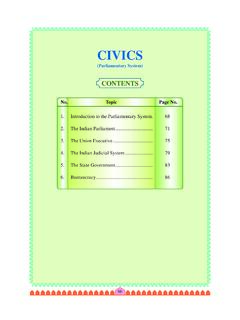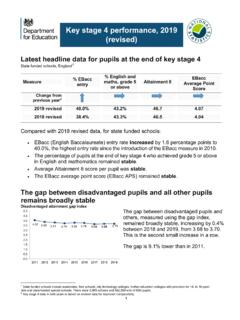Transcription of A guide to exclusion statistics - GOV.UK
1 A guide to exclusion statistics Last updated: September 2017. Contents 1. Introduction 4. Requirements of schools 4. Uses and Users 4. 2. Background to published statistics 5. Current publications 5. Key exclusion measures 5. Cohort used in exclusion measures 5. Lunch time exclusions 6. Published geographical and characteristics breakdowns 6. Appeals and reviews relating to permanent exclusion 6. Underlying data provided alongside publications 6. Suppression of exclusions data 7. Other related publications 7. Devolved administration statistics on exclusions 8. 3. Methodology 9. Calculation of exclusion rates 9. 2013/14 releases onwards 9. Releases prior to 2013/14 10. Appeals and reviews relating to permanent exclusions 11. 2012/13 onwards (reviews of permanent exclusions) 11. Prior to 2012/13 (appeals against permanent exclusions) 12.
2 4. Data collection 13. The collection process 13. Background to exclusions data collection 13. 2005/06 to present: Pupil level exclusions information is collected via the school census 13. 2002/03 to 2004/05: Termly permanent and fixed period exclusions information was collected via the termly exclusions survey 14. 1994/95 to 2001/02: Permanent exclusions are collected via the annual school census 15. 2. Data coverage 15. Coverage for 2006/07 to present 15. Coverage for 2005/06 16. Coverage for 1994/95 to 2004/05 16. What exclusions information is collected 17. Category of exclusion 17. Reason for exclusion 17. Start date of exclusion 18. Length of exclusion in sessions 19. In care and SEN indicators 19. No longer collected but available historically 19. What exclusion information is not collected 20. Permanent exclusions overturned at governing body consideration stage and at governing body reconsideration stage 20.
3 Specific details of exclusion incident 20. Exclusions data for independent schools 20. 5. Data processing 21. Data linking 21. Data removed 21. Variables added 22. Pupils with one or more fixed period exclusion 22. School type, academy type 22. Data quality 22. Data checking 23. 6. Contacts 24. Annex A - Glossary 25. Annex B - Calculations 26. Annex C exclusion by reason codes 27. Annex D Links to pupil exclusions statistics 28. Annex E Standard breakdowns that are currently published 30. 3. 1. Introduction This document provides a comprehensive guide to the permanent and fixed period exclusions in schools in England statistics published by the Department for Education. The key areas covered in this guide are: Background to published statistics and methodology Data collection and coverage Data processing Requirements of schools The head teacher of a school can exclude a pupil on disciplinary grounds only.
4 Good discipline in schools is essential to ensure that all pupils can benefit from the opportunities provided by education. The decision to exclude a pupil must be lawful, reasonable and fair. In addition, schools have a statutory duty not to discriminate against pupils on the basis of protected characteristics , such as disability or race. Schools and LAs must arrange alternative provision from the sixth day of the exclusion of pupils of compulsory school age. Further information is available in the Departmental advice on school exclusion . Uses and Users Data used to derive published exclusion statistics are collected via the school census. There is widespread use of data from the schools census. In addition to mainstream and specialist media coverage of our statistical publications that data are used by a range of companies. These include housing websites such as Rightmove and Zoopla, specialist publications such as the good schools guide , organisations providing data analysis services to schools such as Fischer Family Trust.
5 The data is well used by the academic research community ( Durham University), education think tanks (Education Policy Institute). It is also used by central government (DfE, Ofsted, other government departments). The published data are used frequently in answers to parliamentary questions and public enquiries, including those made under the Freedom of Information Act. 4. 2. Background to published statistics Current publications The Department publishes annual exclusions data via the Permanent and fixed- period exclusions in England National statistics release in July each year. The Department's exclusions statistical releases have been badged as National statistics since the 1999/2000 academic year publication. Links to all exclusions publications can be found in Annex D. Key exclusion measures The Department monitors levels of exclusion using key measures based on two types of exclusion permanent and fixed period.
6 Permanent exclusion refers to a pupil who is excluded and who will not come back to that school (unless the exclusion is overturned). Fixed period exclusion refers to a pupil who is excluded from a school for a set period of time. A fixed period exclusion can involve a part of the school day and it does not have to be for a continuous period. A pupil may be excluded for one or more fixed periods up to a maximum of 45 school days in a single academic year. This total includes exclusions from previous schools covered by the exclusion legislation. Pupils with one or more fixed period exclusions refer to pupil enrolments who have at least one fixed period exclusion across the full academic year. It includes those with repeated fixed period exclusions. See the Calculation of exclusion rates section for further information. Cohort used in exclusion measures Exclusions information relates to all exclusions reported across the full academic year.
7 However, exclusion rates are calculated as a proportion of all pupils on roll as at the January Census day of the relevant academic year. 5. Lunch time exclusions The Department also collects lunch time exclusions via the School Census. This is where a pupil whose behaviour at lunchtime has been disruptive such that they are excluded from the school premises for the duration of the lunchtime period. However, these figures are not reported in published exclusions statistics and they are not included in fixed period exclusion totals. Published geographical and characteristics breakdowns The Department routinely publishes pupil exclusions information at national and local authority level including breakdowns by pupil characteristics . School level data are also released, but it should be noted that the Department does not hold individual schools to account based purely on their exclusion figures and does not set exclusion thresholds or targets on the use of exclusion .
8 Ofsted assesses schools' use of exclusion as part of inspection arrangements. A list of all routinely published breakdowns is available in Annex E. Appeals and reviews relating to permanent exclusion In addition to permanent and fixed period exclusions figures, statistical releases also include information on the number of appeals and reviews relating to permanent exclusions as reported by local authorities. For further information see the Appeals and reviews relating to permanent exclusions section. Underlying data provided alongside publications From the 2008/09 academic year, each statistical release has been accompanied by underlying data, including national and local authority information. Alongside the underlying data there is an accompanying document (metadata) which provides further information on the contents of these files.
9 This data is released under the terms of the Open Government License and is intended to meet at least 3 stars for Open Data. 6. Suppression of exclusions data The Code of Practice for Official statistics requires that reasonable steps should be taken to ensure that all published or disseminated statistics produced by the Department for Education protect confidentiality. To do this totals are rounded and small numbers are suppressed according to the following rules: Pupil and exclusion numbers of 1 or 2 are suppressed to protect pupil confidentiality. Where the numerator or denominator of any percentage calculated on pupil or exclusion numbers of 1 or 2, the percentage is suppressed. This suppression is consistent with the Departmental Statistical Policy Statement on Confidentiality. Pupil and exclusion numbers at national and regional levels are rounded to the nearest 5.
10 Where any number is shown as 0, the original figure was also 0. Symbols used to identify this in published tables are as follows: 0 Zero x Small number suppressed to preserve confidentiality . Not applicable .. Not available Note, for individual publications prior to the 2015/16 academic year different rounding and suppression conventions have been used, but to assist users a full time series data have been made available within the latest published time series tables and underlying data. Other related publications Pupil exclusions information is also available in the following publications: The A profile of pupil exclusions research report, published in February 2012, provided an in depth analysis of exclusions from schools in England Other Statistical First Releases published by the Department: o Children in Need o Children looked after o Special Educational Needs: an analysis 7.













